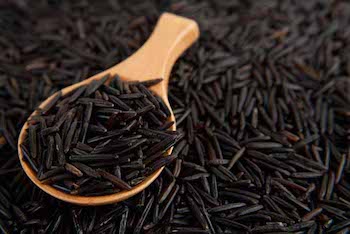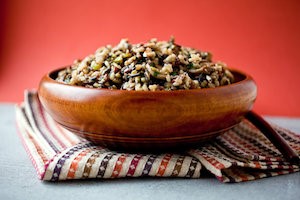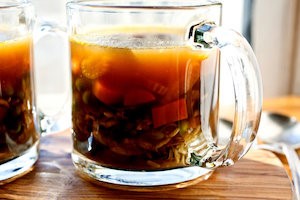Unlock the Health Benefits of Wild Rice After Your Operation
back
In one of our recent blog posts touting the health benefits of Peri-operative Therapy, we discussed a few of the many ways in which creating and sticking to a healthy food plan can make your recovery after surgery faster and more pleasant.
In one of our tips in that article we mentioned that whole grains are a healthier and tastier choice. We mentioned brown rice in particular because it contains more fiber, protein, potassium, folate, and other important nutrients than does white rice.
Well, get ready to have your mind blown, because one of our readers, who is a health blogger herself, reminded us that there is still another whole grain option for those of us seeking whole grains that are both healthy and delicious: wild rice. And the health benefits of wild rice are even more dramatic than we expected.
Just What is Wild Rice?
Technically, wild rice is not rice at all, but (depending on the variety) the seed of a type of grass. It ranges in color from dark to light brown. In many Native American cultures – particularly those of the upper midwest and stretching into Canada – the health benefits of wild rice were widely known through folkways, and the grain was often considered a sacred part of their religious traditions.
Today, largely thanks to the fact that wild rice health benefits are more widely known, the grain has become a valuable source of income for many of these tribes, as well as a concrete way in which to preserve and protect cultural traditions endangered by the ever-encroaching modern world.
Traditionally, wild rice is harvested by canoe: one worker paddles or pushes slowly through the stand of plants, while another gently bends the tops of the plants over, gently brushing mature grains into the canoe using wooden sticks called ‘knockers.’ Wild rice has been cultivated commercially in the Americas since the 1950s.
The Health Benefits of Wild Rice Make it a Great Addition to Your Post-Op Diet
Writer and blogger Sally Perkins happened upon our blog post last month and was inspired to send us some more information about the health benefits of wild rice, and why it’s such a great addition to your Peri-operative regimen. She also sent us a link to a great resource that she put together on wild rice health benefits. It includes a more detailed breakdown of the important nutrients present, and a nutritional comparison of wild rice versus its white and brown cousins. She takes a look at the heart health benefits of wild rice also.
Sally is a professional writer and blogger with many years of experience across a variety of fields. Sally made the move to freelancing from a corporate career in order to seek a more fruitful work-life balance. When not writing, she enjoys reading, hiking, spending time with her family, and travelling as much as possible.
Here are a few of Sally’s thoughts on how wild rice health benefits extend to postoperative recovery.

"When you're recovering from surgery or an illness, it's more important than ever to help aid your body's recovery with the right food and nutrients. A diet that contains more natural foods that supply these nutrients is a simple way to ensure you're getting everything you need. Wild rice is a long-acknowledged natural food, and as a result it has a host of health benefits that could really help you on your road to full recovery.
The health benefits of wild rice include:
- It’s full of antioxidants – This is good for your skin, in terms of promoting general health as well as preventing some signs of aging
- It contains a wide variety of nutrients – These help your body stay healthy
- It’s a great ‘free-from’ option – Wild rice doesn’t contain gluten, and is low in sodium, calories, & fat
Wild rice naturally contains many vitamins that can help your body heal and become stronger. To ensure your body gets all those great nutrients however, you need to make sure that the wild rice you’re buying truly is what it claims to be. There are a variety of wild rice options for sale, and not all of them are grown and cultivated in a way that means the rice is truly, ‘wild.'
If you're interested in finding out how to select the healthiest version of wild rice, and to explore exactly why this whole grain is so important in aiding your body through recovery, check out my guide to the health benefits of wild rice."
A Wild Rice Recipe
Of course all of these great wild rice health benefits don’t mean anything if you don’t know how to cook wild rice deliciously. Some traditional Native American wild rice recipes included stewing the whole grains with deer broth, sometimes adding maple syrup. Maple syrup was also used to make sweets such as wild rice pudding, or puffed wild rice. Recipes also existed for stuffing wild birds with the delicious grain.
Needless to say, the goal for most of us during recovery isn’t to head out into the woods on a quest. We are simply trying to find out how to cook wild rice as simply and deliciously as possible, because – as Sally’s guide indicates – there is a small possibility that issues could crop up if you don’t store and prepare your wild rice correctly.
To that end, we’ve included one of our favorite wild rice recipes from one of our favorite cookbook authors.
Martha Rose Schulman’s Wild Rice and Mushroom Soup
 |
INGREDIENTS
|
- 2 medium carrots, diced
- 2 ribs celery, diced
- ½ pound cremini or button mushrooms, cleaned, trimmed, and sliced thick
- 2 large garlic cloves, minced
- Salt to taste
- ⅔ cup wild rice
- 2 quarts chicken stock, vegetable stock or water
- A bouquet garni made with a few sprigs each thyme and parsley, a bay leaf and a Parmesan rind
- 1 cup frozen peas, thawed
- Freshly ground pepper to taste
PREPARATION
- Place the dried porcini mushrooms in a bowl or a Pyrex measuring cup, and pour on 2 cups boiling water. Let sit for 30 minutes. Set a strainer over a bowl and line it with cheesecloth. Lift the mushrooms from the water, and squeeze them over the strainer. Rinse in several changes of water, squeeze out the water and set aside. Pour the soaking water through the cheesecloth-lined strainer, and set aside.
- Heat the oil in a large, heavy soup pot or Dutch oven over medium heat. Add the onion, carrot and celery. Cook, stirring often, until just about tender, about five minutes. Add the sliced fresh mushrooms. Cook, stirring, until the mushrooms are beginning to soften, about three minutes. Add the garlic and a generous pinch of salt.
- Continue to cook for about five minutes until the mixture is juicy and fragrant. Add the reconstituted dried mushrooms, the wild rice, bouquet garni, mushroom soaking liquid, stock or water, and salt to taste.
- Bring to a boil, reduce the heat, cover and simmer one hour. Add the peas, and simmer another 10 minutes.
- Remove the bouquet garni, taste and adjust salt, add a generous amount of freshly ground pepper and serve.
Combined with Peri-operative Therapy, a healthy food plan – including this delicious wild rice recipe – will help keep your healing process on track.
Be sure to check out Sally's work, and call 303-628-0205 to set up your next appointment with Soulstice.
